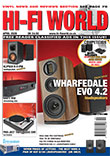Page 2 of 5
A drawback of this is that the optical input receivers of many DACs work to 24/96kHz maximum, so play a 192kHz sample rate file (24bit) and the system falls mysteriously silent. I value the presence of a digital output because it allows me to hook up a player to the hi-fi via a mains powered DAC, bypassing the battery powered audio output stages that, as good as they may be, never match mains powered circuits in sound quality – always short of dynamic punch. To the right of the headphone socket lies the strange and almost unusable 2.5mm four-pole socket that offers balanced output (also used by Astell&Kern). I spotted what looks like an adapter and a pair of XLR line plugs on the website, so balanced analogue audio can be taken to the hi-fi if you obtain these bits, but digital linking is preferable. You can also connect up headphones balanced as I did with my Oppo PM1s, for slight improvement in sound quality if, that is, you can get hold of a suitable headphone cable terminated with a miniature 2.5mm four-pole plug.
At top sit a 3.5mm stereo headphone socket, with coaxial digital output, and 2.5mm four-pole balanced output socket.
I soldered up such a cable some time ago, using an illuminated bench magnifier (Maplins again) and it was difficult. The plug body is too small to accept twin screened cables. Also, the plugs are so weak they snap in use! So you can get balanced sound – but not easily, nor for very long. There is 128GB of internal memory and one microSD card slot that will address up to 200GB. An ARM Cortex quad-core A9 processor handles all processes, making the Opus 2 fast and slick to use. Its user interface is easy enough to handle, helped by a swipe down screen with all main functions on it, as well as the inevitable Settings menu. All the usual options such as Gapless playback, Equaliser and what have you are provided, but there are no filter options. There is a USB DAC option, however, that allows the unit to be used as a quality headphone amp with a computer, connected through its microUSB input/charging cable. All the usual file formats can be read, including WAV, FLAC and Apple's ALAC and AIFF. There's OGG and APE too, as well as DSD (64&128) with the DFF and DSF file tags. |
Search
Hi-Fi World, Powered by Joomla!; Hosted by Joomla Wired.







